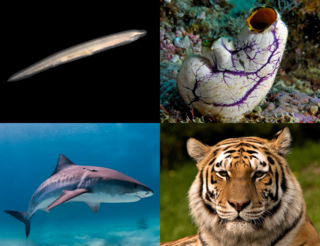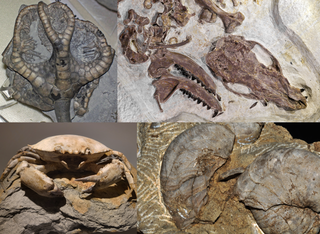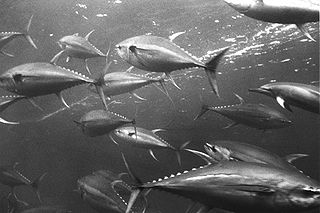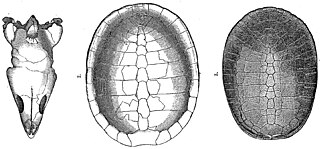
A chordate is a deuterostomal bilaterian animal belonging to the phylum Chordata. All chordates possess, at some point during their larval or adult stages, five distinctive physical characteristics (synapomorphies) that distinguish them from other taxa. These five synapomorphies are a notochord, a hollow dorsal nerve cord, an endostyle or thyroid, pharyngeal slits, and a post-anal tail.

A fossil is any preserved remains, impression, or trace of any once-living thing from a past geological age. Examples include bones, shells, exoskeletons, stone imprints of animals or microbes, objects preserved in amber, hair, petrified wood and DNA remnants. The totality of fossils is known as the fossil record. Though the fossil record is incomplete, numerous studies have demonstrated that there is enough information available to give a good understanding of the pattern of diversification of life on Earth. In addition, the record can predict and fill gaps such as the discovery of Tiktaalik in the arctic of Canada.

The mackerel, tuna, and bonito family, Scombridae, includes many of the most important and familiar food fishes. The family consists of 51 species in 15 genera and two subfamilies. All species are in the subfamily Scombrinae, except the butterfly kingfish, which is the sole member of subfamily Gasterochismatinae.

The Caridea, commonly known as caridean shrimp or true shrimp, from the Greek word καρίς, καρίδος, are an infraorder of shrimp within the order Decapoda. This infraorder contains all species of true shrimp. They are found widely around the world in both fresh and salt water. Many other animals with similar names – such as the mud shrimp of Axiidea and the boxer shrimp of Stenopodidea – are not true shrimp, but many have evolved features similar to true shrimp.

Tarsiers are haplorhine primates of the family Tarsiidae, which is, itself, the lone extant family within the infraorder Tarsiiformes. Although the group was, prehistorically, more globally widespread, all of the species living today are restricted to Maritime Southeast Asia, predominantly being found in Brunei, Indonesia, Malaysia and the Philippines.

A living fossil is an extant taxon that phenotypically resembles related species known only from the fossil record. To be considered a living fossil, the fossil species must be old relative to the time of origin of the extant clade. Living fossils commonly are of species-poor lineages, but they need not be. While the body plan of a living fossil remains superficially similar, it is never the same species as the remote relatives it resembles, because genetic drift would inevitably change its chromosomal structure.

The Ulmaceae are a family of flowering plants that includes the elms, and the zelkovas. Members of the family are widely distributed throughout the north temperate zone, and have a scattered distribution elsewhere except for Australasia.
Neogaeornis is a controversial prehistoric genus of diving bird. The single known species, Neogaeornis wetzeli, was described from fossils found in the Campanian to Maastrichtian Quiriquina Formation of Chile. It lived about 70-67 million years ago. It remains known from the single tarsometatarsus described in 1929 by Lambrecht, and today housed in the Paläontologisches Institut und Museum in Kiel, Germany.
Paleontology or palaeontology is the study of prehistoric life forms on Earth through the examination of plant and animal fossils. This includes the study of body fossils, tracks (ichnites), burrows, cast-off parts, fossilised feces (coprolites), palynomorphs and chemical residues. Because humans have encountered fossils for millennia, paleontology has a long history both before and after becoming formalized as a science. This article records significant discoveries and events related to paleontology that occurred or were published in the year 1998.

Glyptops is an extinct genus of pleurosternid freshwater turtle known from the Late Jurassic of North America.

The Diplostraca or Cladocera, commonly known as water fleas, is a superorder of small, mostly freshwater crustaceans, most of which feed on microscopic chunks of organic matter, though some forms are predatory.

Goneplax rhomboides is a species of crab. It is known by the common name angular crab because of its angular carapace. Although it is also called the square crab, its shell is in fact more trapezoidal than square. This species is also known as the mud-runner because they are able to run away quickly when threatened.

Goneplacidae is a family of crabs of the order Decapoda and the superfamily Goneplacoidea. It includes the following genera:

Eryonidae is a family of fossil decapod crustaceans which lived from the Upper Triassic to the Lower Cretaceous. It contains four genera: An aggregation of three unidentified eryonids was reported in 2012 inside a Late Jurassic ammonoid of the species Harpoceras falciferum; they represent the earliest evidence of gregarious behaviour in decapods.

Baenidae is an extinct family of paracryptodiran turtles known from the Early Cretaceous to Eocene of North America. While during the Early Cretaceous they are found across North America, during the Late Cretaceous they are only found in Laramidia, having disappeared from Appalachia. The majority of lineages survived the K-Pg Extinction, but the family was extinct by the latest Eocene. The name of the type genus, Baena, appears to be of Native American origin, likely from the Arapaho be’enoo. They are primarily found in freshwater deposits, and are considered to be aquatic, with a largely generalist habit.

Around 65 species of crab occur in the waters of the British Isles. All are marine, with the exception of the introduced Chinese mitten crab, Eriocheir sinensis, which occurs in fresh and brackish water. They range in size from the deep-water species Paromola cuvieri, which can reach a claw span of 1.2 metres, to the pea crab, which is only 4 mm (0.16 in) wide and lives inside mussel shells.
Coelodontognathus is an extinct genus of reptile from the Early Triassic of European Russia. It was originally described as a procolophonid parareptile in 1967 but was reclassified as a possible trilophosaurid archosauromorph in 2008. The genus includes two species: the type species C. donensis and C. ricovi. C. donensis is known from the holotype PIN 4173/129 and the referred PIN 4173/130, and C. ricovi is known from the holotype PIN 4173/127 and the referred PIN 4173/128, all of which represent dentaries that are housed at the Paleontological Institute, Russian Academy of Sciences. Another dentary, SGU 104/3105, originally referred to C. donensis was reassigned to its own genus and species Vitalia grata by Ivakhnenko, 1973. The fossils have been found at the Donskaya Luka Locality near the village of Sirotinskaya and the Don River in Ilovlinsky District, Volgograd Oblast, from the Lipovskaya Formation of the Gamskii Horizon. Like Coelodontognathus, Vitalia which is known from the same locality was also first identified as a procolophonid and later reclassified as a trilophosaurid. Coelodontognathus and Vitalia are similar to procolophonids in that they have wide teeth but differs from them in that they have tooth roots set deep into the jaws.
Hypericum holyi is an extinct species of the genus Hypericum that was present from the Lower Miocene to the Upper Miocene. Fossil seeds of the species have been found in Central Europe in general and Central Jutland, Denmark, in particular.

Goneplax is a genus of crabs, in the family, Goneplacedae, containing the following extant species:















